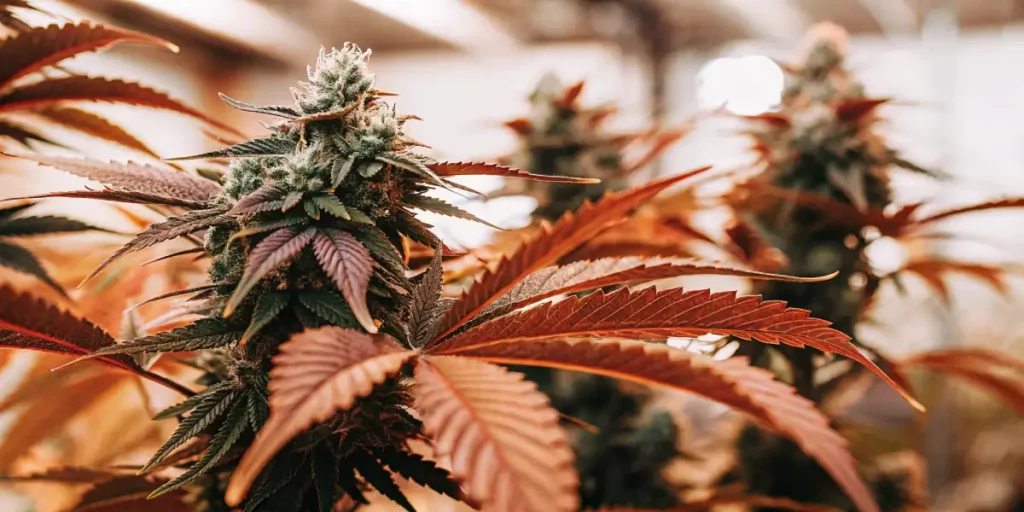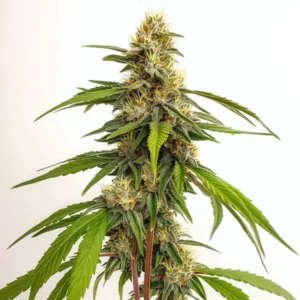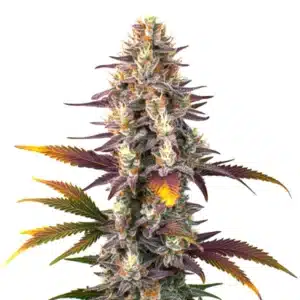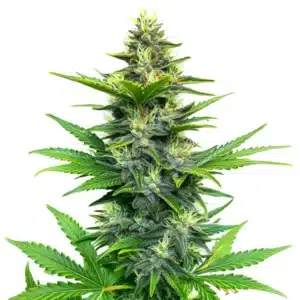Critical Weed Regular Strain Description
Critical Regular is an incredible strain known for its balance between ease of cultivation and high-quality yields. It is a hybrid, leaning slightly toward Indica, with a powerful lineage that includes Critical Mass and AK47. This combination produces a versatile plant that is perfect for cultivators looking for potency and abundant yields. It’s a medium THC strain, ranging between 15% to 20%, offering a soothing yet energetic experience.
The critical strain grow info highlights its highly admired sweet, citrusy flavor profile, which makes each inhale refreshing. Its tightly packed buds are covered in resinous trichomes, delivering a strong and relaxing high that makes it ideal for both recreational and medicinal users. Critical Regular is renowned for its calming effects, especially for treating stress, muscle spasms, and fatigue, providing relief without knocking you out completely. For those interested in critical strain, this variety is also known for being relatively easy to cultivate, making it a popular choice for both beginner and seasoned growers.
Recommended Strains
Critical Regular
 THC: 15% - 20%
THC: 15% - 20% Type of seed: Regular
Type of seed: Regular Phenotype: Mostly Indica
Phenotype: Mostly Indica Day to flower: 7 - 9 weeks
Day to flower: 7 - 9 weeks
Promos & Deals
Environmental Requirements for Growing Critical Weed Regular
Creating the right growing environment for Critical Weed Regular is key to maximizing its potential. This strain thrives in a temperate climate with steady temperatures between 70°F and 80°F (21°C and 27°C). Indoor growers should ensure stable temperatures, while outdoor growers need to find a spot that offers plenty of sunlight. Humidity control is also essential, with levels between 40% and 50% being ideal for this strain.
Lighting is crucial for the success of Critical Regular. Indoors, using powerful LED or HPS lights ensures sufficient light intensity for strong bud development. Outdoor growing benefits from sunny, warm locations where the plant can thrive under natural light. Ventilation is equally important to avoid mold or mildew, especially in the flowering stage, where dense buds require optimal airflow.
Setting Up the Growing Space for Critical Weed Regular
Indoor Cannabis Cultivation
For those growing indoors, selecting the proper grow tent or room with appropriate ventilation is critical. Set up an exhaust system to manage heat and humidity, and use reflective materials to ensure even light distribution. The strain grows up to 4.92 feet (1.5 meters), so make sure to provide adequate vertical space for growth. A good ventilation system will prevent mold buildup, which can be an issue due to the density of the buds.
For the growing medium, Critical Weed Regular adapts well to both soil and hydroponic setups. However, make sure the soil is nutrient-rich and well-draining. Keep the pH around 6.0 to 6.5 to ensure maximum nutrient absorption. For hydroponic setups, focus on precise nutrient control, as this strain responds well to balanced feeding.
Outdoor Cannabis Cultivation
When growing outdoors, choose a location with well-draining soil and ample sunlight. The strain’s robust nature means it can thrive in outdoor conditions if provided with good care. Consider using large containers to maintain control over the soil’s quality. Additionally, outdoor growers can benefit from using natural stakes or trellises to support the heavy buds during the later stages of growth. Due to the plant’s height and bud density, additional support is often necessary to avoid breaking stems.

Propagation and Germination of Critical Weed Regular
Successful propagation of Critical Weed Regular begins with selecting high-quality seeds. For germination, the seeds should be soaked in distilled water or placed in a moist paper towel for about 24-48 hours until they sprout. The ideal temperature for germination is between 70°F and 85°F (21°C to 29°C).
Once germinated, transfer the seeds into a light, well-draining soil mix. Make sure to plant the seeds in a controlled environment where they are kept moist but not waterlogged. Use a humidity dome to maintain humidity levels around 60%-70%, which promotes faster germination.
After a few days, the seedlings should be ready to develop their first true leaves. From there, they can be transplanted into larger pots or outdoor soil where they will begin their vegetative phase.
Vegetative Phase of Critical Weed Regular Strain
The vegetative stage is where the plant begins to bulk up. Ensure that the plants receive 18-20 hours of light per day during this phase, whether you’re using LED or HPS lights. Light intensity is crucial for photosynthesis, helping the plants grow larger and more robust.
During this phase, your Critical Regular plants need a higher amount of nitrogen for healthy leaf and stem development. You should water them when the top inch of soil is dry to prevent overwatering, which could lead to root rot. Maintain optimal temperatures between 70°F and 80°F, with humidity levels around 60%.
If you’re growing indoors, consider low-stress training (LST) techniques like tying down the branches to allow more light to reach the inner parts of the plant. You can also use topping to control the height of the plants and ensure more even bud development.
Flowering Phase of Critical Regular
When transitioning to the flowering phase, reduce the light cycle to 12 hours of light and 12 hours of darkness. This will signal the plant to stop vegetative growth and focus on producing buds. The flowering period for Critical Weed Regular lasts between 8 and 10 weeks, during which the plant’s resin-coated buds will develop their characteristic potency.
During the flowering stage, switch to bloom nutrients rich in phosphorus and potassium to support the formation of large, dense buds. Keep the environment well-ventilated and reduce humidity levels to around 40%-50% to avoid issues with mold or bud rot. The temperature should be kept slightly lower, ideally between 65°F and 75°F, to enhance resin production.
Cannabis Fertilization and Nutrition for Critical Regular
To ensure your plants reach their maximum potential, feeding them the right nutrients is essential. During the vegetative stage, focus on nitrogen-rich nutrients. As the plant transitions to flowering, shift to a fertilizer that is higher in phosphorus and potassium, such as bloom boosters.
In addition to basic nutrients, you may want to include organic supplements like beneficial microbes and enzymes to improve soil health. Be sure to monitor the plants closely for any signs of nutrient deficiencies, such as yellowing leaves or stunted growth.
Pest and Disease Control for Growing Critical Regular
Although Critical Weed Regular is a robust strain, it is still vulnerable to pests and diseases. Preventative measures like maintaining clean grow spaces and regular inspections can help avoid infestations. Introducing beneficial insects like ladybugs can keep pest populations in check without using harmful chemicals.
In cases where pests are detected, opt for organic solutions like neem oil or insecticidal soap. For fungal infections like powdery mildew, increasing airflow and using natural fungicides can be effective in keeping the disease under control.
Harvesting and Curing Critical Regular
Critical Weed Regular is typically ready for harvest after 8 to 10 weeks of flowering. Look for the trichomes to turn milky or amber to determine when your plant is at its peak. Use a magnifying glass to inspect the buds carefully.
After harvesting, hang the branches upside down in a dark, cool area with a temperature of around 60-70°F and humidity between 50%-60%. Once dried, cure the buds in airtight jars, opening them daily for the first week to let out excess moisture. This curing process enhances the flavor and potency of your final product.

Is Critical Weed Regular Indica or Sativa?
Critical Weed Regular is predominantly Indica, with a slight Sativa influence due to its AK47 lineage. This results in a strain that provides a relaxing body high while keeping your mind clear and focused. The hybrid nature makes it versatile, offering both physical relief and a light, talkative energy for social settings.
Advantages of Growing Critical Regular
- Easy to grow with medium difficulty.
- High yields, especially in indoor setups.
- Delivers a well-balanced high suitable for various activities.
- Resilient to common cannabis-growing issues like mold.
- Sweet, citrus flavor profile appeals to a wide range of users.
Disadvantages of Growing Critical Regular
- Requires humidity control, especially in flowering.
- Needs support during the flowering stage due to heavy buds.
- Moderate odor during flowering requires odor control solutions.
Why Buy Critical Regular
Critical Weed Regular is the perfect choice for growers who seek high yields and potent effects without too much hassle. Its balance of relaxing body effects and uplifting mental clarity makes it a favorite among users looking for a versatile strain. Additionally, its sweet, citrus flavor adds an extra layer of enjoyment to the experience.
Common Problems in Growing Critical Weed Regular
- Overfeeding can lead to nutrient burn, especially during the flowering stage.
- High humidity can result in mold and bud rot if not properly managed.
- Outdoor growers in humid climates may need to take extra precautions to avoid pest infestations.
- Bud-heavy plants require support to avoid branches breaking under their weight, especially in outdoor grows.
Being aware of these issues and taking preventative measures can ensure that you grow healthy, robust Critical Regular plants that produce top-quality yields.
Similar Strains to Critical Weed Regular
If you enjoy growing Critical Weed Regular, you might want to consider cultivating similar strains that offer unique but comparable qualities. Here are three strains that are worth exploring:
White Widow Regular: is another popular hybrid strain that combines both Sativa and Indica traits. Like Critical Strain Regular, it offers a balanced high but with more energetic effects. Its ease of growth and resilience to pests make it an excellent alternative for cultivators looking for a strong and versatile plant.
Northern Lights Regular: is a famous Indica-dominant strain known for its relaxing effects and ease of cultivation. It’s a perfect option for growers looking for a strain that can relieve stress and pain while delivering solid yields. Northern Lights shares some genetic similarities with Critical, particularly in its resilience and flowering time.
AK47 Regular: is a classic strain that offers a bit more Sativa influence. It provides uplifting effects with a cerebral high, making it ideal for daytime use. It’s also a favorite among cultivators for its adaptability in both indoor and outdoor environments.
Tips for Professional Growers
Professional growers can optimize the growth of Critical Weed Regular by implementing advanced techniques that go beyond standard cultivation practices. Here are a few expert tips:
Use Low-Stress Training (LST)
Professionals can benefit from using LST techniques to maximize light exposure and increase yield. By gently bending the branches and securing them in place, you can create a more even canopy that allows all parts of the plant to receive optimal light.
Maintain Precise Climate Control
For those growing indoors, investing in climate control equipment can make all the difference. Critical Weed Regular thrives in controlled environments where temperature and humidity are kept at consistent levels. Using automated systems can ensure that the plant remains stress-free throughout its growth cycle.
Utilize Hydroponics for Faster Growth
Hydroponic setups are ideal for experienced growers looking to push the limits of growth speed and yields. With precise control over nutrients and water supply, hydroponics can lead to faster vegetative growth and larger buds during the flowering phase.
FAQs about Growing Critical Weed Regular
What is the ideal growing environment for Critical Regular?
This strain thrives in a temperate climate with consistent temperatures between 70°F and 80°F (21°C and 27°C) and humidity levels between 40%-50%. It can be grown both indoors and outdoors, though indoor cultivation provides more control over the environment.
How long does it take to grow Critical Regular?
The total grow time from seed to harvest is typically around 8 to 10 weeks, depending on the specific growing conditions and phenotype. The flowering time itself lasts between 8 to 10 weeks.
What nutrients are best for Critical Regular?
During the vegetative phase, use a nitrogen-rich nutrient mix to promote healthy foliage. As the plant transitions to flowering, switch to a nutrient solution higher in phosphorus and potassium to support bud development.
Can beginners grow Critical Regular?
This strain is best suited for non-beginners due to its medium difficulty. While not overly challenging, it requires careful management of humidity and nutrients to avoid common growing issues such as mold and nutrient burn.
What are the main effects of Critical Regular?
Critical Weed Regular offers a happy, relaxed, and talkative effect. It is perfect for those looking for a strain that provides both physical relaxation and mental stimulation without overwhelming sedation.
How many leaves on weed plants is normal?
Most healthy cannabis plants develop 5, 7, or even 9 leaflets, depending on the strain and growing conditions.

















